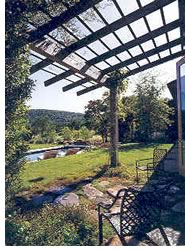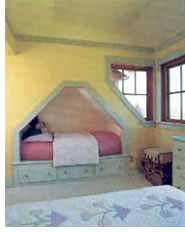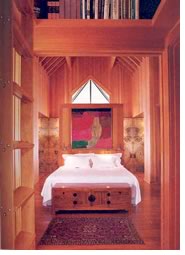
by Max Jacobson, AIA; Murray Silverstein, AIA; and Barbara Winslow, AIA, (Taunton Press, 2002)

Stephanie Stubbs, Assoc. AIA
Managing Editor
 Back
in school, we were absolutely awed by Christopher Alexander's A
Pattern Language; so much so that we spent days traipsing around
our converted warehouse of a school and its surround searching for evidence
of "patterns." With more than 200 patterns at our disposal,
even we students had no trouble finding them. The reason for the immense
appeal is that the patterns were Truth—they were architecture theory
in the flesh for us. They also offered a way to crack the code, to pull
single threads out of the complicated tapestry of what we were trying
so hard to figure out: how you design firm, commodious, and delightful
buildings.
Back
in school, we were absolutely awed by Christopher Alexander's A
Pattern Language; so much so that we spent days traipsing around
our converted warehouse of a school and its surround searching for evidence
of "patterns." With more than 200 patterns at our disposal,
even we students had no trouble finding them. The reason for the immense
appeal is that the patterns were Truth—they were architecture theory
in the flesh for us. They also offered a way to crack the code, to pull
single threads out of the complicated tapestry of what we were trying
so hard to figure out: how you design firm, commodious, and delightful
buildings.
 It
is perhaps even more difficult to convey the interwoven complexity of
design to clients than to architecture students. Three architects—Max
Jacobson, AIA; Murray Silverstein, AIA; and Barbara Winslow, AIA—have
given us a useful tool to help convey the magic: it's a book called Patterns
of Home: The Ten Essentials of Enduring Design. The authors, two
of whom worked on the original pattern language with Alexander at the
Center for Environmental Architecture in Berkeley, and all of whom are
principals at JSW Architects, offer 10 "patterns of home," complex
rules that designers employ—often intuitively—to design great
houses. Following the intent of the original Pattern
Language, the patterns of home allow clients and interested laypeople
to understand (and articulate!) what resonates in a residence for them.
It
is perhaps even more difficult to convey the interwoven complexity of
design to clients than to architecture students. Three architects—Max
Jacobson, AIA; Murray Silverstein, AIA; and Barbara Winslow, AIA—have
given us a useful tool to help convey the magic: it's a book called Patterns
of Home: The Ten Essentials of Enduring Design. The authors, two
of whom worked on the original pattern language with Alexander at the
Center for Environmental Architecture in Berkeley, and all of whom are
principals at JSW Architects, offer 10 "patterns of home," complex
rules that designers employ—often intuitively—to design great
houses. Following the intent of the original Pattern
Language, the patterns of home allow clients and interested laypeople
to understand (and articulate!) what resonates in a residence for them.
 Ten
essential patterns
Ten
essential patterns
1. Inhabiting the Site. This pattern
embodies thinking of the house and site not only as a singular entity,
but also a part of a larger whole. "Get it right," the authors
say, "and the rest of the design flows smoothly."
2. Creating Rooms, Outside and In.
Looking at the site as a "mosaic of rooms, some inside, some out."
Outdoor rooms should be as clearly defined and invested with purpose as
the inside rooms.
3. Sheltering Roof. "The
overall roof plan, how it orients and shapes the spaces below and around
it, how the parts of the roof are linked, the details of roof construction,
and how they will be expressed inside and out . . . all fit the pattern
of Sheltering Roof."
4. Capturing Light. A house must
be open to the light and warmth of the sun, the authors tell us. And important
rooms must have light from at least two sides.
5. Parts in Proportion. A balanced
whole is composed of parts (which in turn are composed of parts themselves)
that are in balance and scale with each other and the whole itself.
6. The Flow-through Rooms. Proper
flow begins with arriving on the site, how we enter, where we pause, and
how we navigate and move through the rooms themselves.
 7.
Private Edges, Common Core. A good home balances private (some
for everyone!) and communal space and supports these functions through
appropriate lighting, circulation, and room and roof shape.
7.
Private Edges, Common Core. A good home balances private (some
for everyone!) and communal space and supports these functions through
appropriate lighting, circulation, and room and roof shape.
8. Refuge and Outlook. "One
of the abiding pleasures that homes offer is being in and looking out,"
the authors write, "providing a solid, stable, and protected place
from which you can look out toward and over a larger 'beyond.'"
9. Places in Between. This pattern
celebrates those favored areas that are both outside and in: porches,
bay window seat and beds, breezeways, gazebos.
10. Composing with Materials.
"Compose materials as a melody—those that support and underscore;
those that offer counterpoint, slow the procession—all with a view
to letting the building sing."
 Well-crafted,
details and whole
Well-crafted,
details and whole
Patterns of Home is as well crafted
as its theory. As you probably can tell from some of the statements above,
the book is beautifully written, providing thoughtful and almost poetic
descriptions of the case-study houses and their patterns under discussion.
David Livingston's beautiful photos of these exemplary houses are generously
sized—many are full-page—and accompanied by explanatory sketches
and diagrams.
 The
authors fortify the building case studies with boxed discussions of "Patterns
in Context," which explains how several of the patterns are used
in that particular building, and tips of "Working with the Pattern."
Tips presented under "Working with the Pattern" of "Parts
in Proportion" advise us to "organize the house along lines
of movement and growth" and "let the overall form of the house
grow naturally out of the forms of its various parts, rather than being
superimposed from outside. In this sense, the form of the house equals
the form of its parts." When a pattern is in evidence in a chapter
other than its own (e.g., when "Light" shows up in the "Flow-through
Rooms" chapter), it is called out in the text in a highlighted font.
The integration of the patterns becomes apparent.
The
authors fortify the building case studies with boxed discussions of "Patterns
in Context," which explains how several of the patterns are used
in that particular building, and tips of "Working with the Pattern."
Tips presented under "Working with the Pattern" of "Parts
in Proportion" advise us to "organize the house along lines
of movement and growth" and "let the overall form of the house
grow naturally out of the forms of its various parts, rather than being
superimposed from outside. In this sense, the form of the house equals
the form of its parts." When a pattern is in evidence in a chapter
other than its own (e.g., when "Light" shows up in the "Flow-through
Rooms" chapter), it is called out in the text in a highlighted font.
The integration of the patterns becomes apparent.
Patterns of Home would offer a fascinating introduction to clients on how design integration creates residential magic that just "feels right" in a home. They could begin to understand what they are liking and why they are liking it. Anyone who looks at this book, however, will not be able to discount its tremendous appeal for designers and architects. It's integrated work and fun—do you see a pattern here?
Copyright 2002 The American Institute of Architects. All rights reserved.
![]()
|
The holiday season is just around the corner—and this book would be a great gift! Order it from the AIA Bookstore, $31.50 AIA members/$34.95 retail (plus $6 shipping); phone 800-242-3837 option #4, fax 202-626-7519, or send an email. Photos by David Livingston |
|